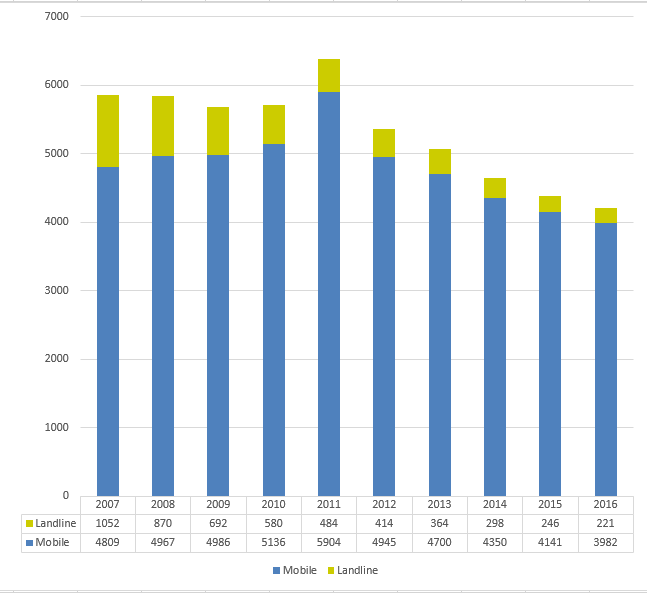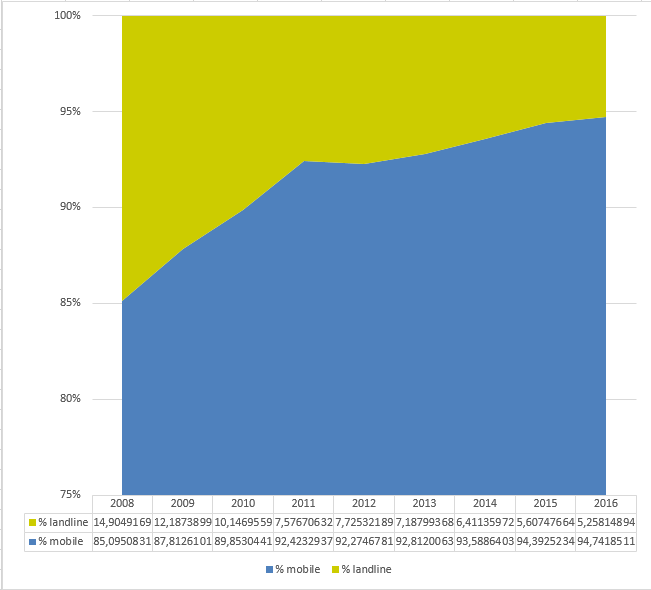Difference between revisions of "Timeline of telephony in Finland"
From Timelines
| Line 53: | Line 53: | ||
|- | |- | ||
| 1999 (July) || || More Finnish households already have a mobile phone than a landline telephone.<ref name="From hand-cranked connections to hands-free mobile calls - history of telecommunications in Finland seen through statistics"/> | | 1999 (July) || || More Finnish households already have a mobile phone than a landline telephone.<ref name="From hand-cranked connections to hands-free mobile calls - history of telecommunications in Finland seen through statistics"/> | ||
| + | |- | ||
| + | | 2000 || || The Finnish telecommunications industry as a whole employs some 83,000 people in over 4000 firms, representing 6.9% of the GDP.<ref name="CASE STUDY NO. 1: MARKET OPENNESS, TRADE LI BERALISATION AND INNOVATION CAPACITY IN THE FINNISH TELECOM EQUIPMENT INDUSTRY"/> | ||
|- | |- | ||
| 2003 || || Manufacturing of telecom equipment represents 90% of total [[w:Information and communications technology|ICT]] manufacturing value-added in Finland.<ref name="CASE STUDY NO. 1: MARKET OPENNESS, TRADE LI BERALISATION AND INNOVATION CAPACITY IN THE FINNISH TELECOM EQUIPMENT INDUSTRY"/> | | 2003 || || Manufacturing of telecom equipment represents 90% of total [[w:Information and communications technology|ICT]] manufacturing value-added in Finland.<ref name="CASE STUDY NO. 1: MARKET OPENNESS, TRADE LI BERALISATION AND INNOVATION CAPACITY IN THE FINNISH TELECOM EQUIPMENT INDUSTRY"/> | ||
| + | |- | ||
| + | | 2000 || || The Finnish telecommunications industry represents 8.4% of the GDP, up from 6.9% in 2000.<ref name="CASE STUDY NO. 1: MARKET OPENNESS, TRADE LI BERALISATION AND INNOVATION CAPACITY IN THE FINNISH TELECOM EQUIPMENT INDUSTRY"/> | ||
|- | |- | ||
| 2006 || || The import of telecom equipment and parts represents over 3% of Finnish GDP. In absolute terms, in Finland, imports of telecom equipment and parts has actually almost been multiplied by ten since 1990.<ref name="CASE STUDY NO. 1: MARKET OPENNESS, TRADE LI BERALISATION AND INNOVATION CAPACITY IN THE FINNISH TELECOM EQUIPMENT INDUSTRY"/> | | 2006 || || The import of telecom equipment and parts represents over 3% of Finnish GDP. In absolute terms, in Finland, imports of telecom equipment and parts has actually almost been multiplied by ten since 1990.<ref name="CASE STUDY NO. 1: MARKET OPENNESS, TRADE LI BERALISATION AND INNOVATION CAPACITY IN THE FINNISH TELECOM EQUIPMENT INDUSTRY"/> | ||
Revision as of 19:55, 25 October 2017
This is a timeline of telephony in Finland.
Contents
Big picture
| Time period | Development summary |
|---|---|
| 1930s | Private telephone companies start being covered by statistics.[1] |
| 1970s | The Nordic mobile telephony (NMT) standard is developed by the Finland’s state-owned Post, Telegraph and Telephone (PTT), in collaboration with the Swedish, Norwegian and Danish PTTs. Finland would become the first country worldwide to launch a digital network for mobile communications.[2] |
| 1980s | The capacities of the NMT networks grow rapidly in the decade.[1] in the mid-1980s, well before its European neighbours, Finland starts deregulating its telecom sector, which would result in a decentralised system of national and foreign - owned telecom operators. An environment of increased competition would provide continuous incentives for upgrading different components of the telecom network and for introducing a variety of technological solutions and innovations among firms participating in the mobile telephony cluster.[2] |
| 1990s | The world’s first Global System for Mobile communications (GSM) is launched as the successor of the NMT. It would subsequently also become the European standard for mobile telecommunications. As a result, Nokia and other Nordic telecom equipment suppliers would benefit from first mover advantages in the mobile telecom industry worldwide.[2] The number of landline telephones reaches its highest in Finnish households in the first half of the decade. After the peak, the number of households with no landline phone would grow rapidly, as a consequence of young people establishing their own households and deciding not to get a landline connection.[1] |
Visual data
Full timeline
| Year | Event type | Details |
|---|---|---|
| 1877 (end of year) | The first telephone line is erected in Helsinki towards the end of the year; 18 months after the telephone was patented in the United States.[1] | |
| 1882 | An early telephone company is founded in Helsinki.[1] | |
| 1924 | The Statistical Yearbook of Finland starts being published, providing data on the activities of the State telegraph and telephone companies.[1] | |
| 1932 | The Finnish Yearbook starts publishing data describing the activities of private telephone companies. Private telephony activity is found to be many times more extensive than that of the State. State telephone companies have 227 exchanges whereas private telephone companies have as many as 1,998 of them. Likewise, in the same year the State has 1,763 "subscriber apparatuses" whereas private telephone companies had 133,456.[1] | |
| 1939 – 1945 | A total of 815 local telephone companies have been set up in Finland by the Second World War.[1] | |
| 1980 | There are almost twice as many telephones per 100 population in Helsinki as in the rest of the country.[1] | |
| 1982 | The automatic NMT (Nordic Mobile Telephone) 450 network first appears in the statistics, with 2,648 subscriptions.[1] | |
| 1987 | The NMT 900 network first appears in the statistics, with 2,038 subscriptions.[1] | |
| 1990 | Data concerning mobile phones ie added to the Finnish Statistical Yearbook, concurrently with data on transmissions networks.[1] | |
| 1990 | The import of telecom equipment and parts represents 0.8% of Finnish GDP.[2] | |
| 1991 | The world’s first Global System for Mobile communications (GSM) is launched in Finland as the successor of the NMT. It would subsequently also become the European standard for mobile telecommunications. As a result, Nokia and other Nordic telecom equipment suppliers benefit t ed from first mover advantage s in the mobile telecom industry worldwide. | |
| 1993 | 94 per cent of all households in Finland have at least one landline telephone.[1] | |
| 1995 | Finland joins the European Union and its Single Market. This would imply a full removal of trade and investment barriers and a substantial increase of trade volumes with other EU member states. Trade in intermediate and finished telecom equipment would be particularly facilitated between Finland and its EU trading partners thanks to the harmonisation of essential product regulations and specifications plus the introduction of the EU Suppliers’ Declaration of Conformity for telecom and electrical equipment and parts among EU countries.[2] | |
| 1999 (July) | More Finnish households already have a mobile phone than a landline telephone.[1] | |
| 2000 | The Finnish telecommunications industry as a whole employs some 83,000 people in over 4000 firms, representing 6.9% of the GDP.[2] | |
| 2003 | Manufacturing of telecom equipment represents 90% of total ICT manufacturing value-added in Finland.[2] | |
| 2000 | The Finnish telecommunications industry represents 8.4% of the GDP, up from 6.9% in 2000.[2] | |
| 2006 | The import of telecom equipment and parts represents over 3% of Finnish GDP. In absolute terms, in Finland, imports of telecom equipment and parts has actually almost been multiplied by ten since 1990.[2] | |
| 2007 (August) | August 2007, only 41 per cent of households still had a landline telephone while 97 per cent had at least one mobile phone. |
Meta information on the timeline
How the timeline was built
The initial version of the timeline was written by User:Sebastian.
Funding information for this timeline is available.
What the timeline is still missing
Visual data Visual data [1] [2] [3] book book
Timeline update strategy
See also
External links
References
- ↑ 1.00 1.01 1.02 1.03 1.04 1.05 1.06 1.07 1.08 1.09 1.10 1.11 1.12 1.13 "From hand-cranked connections to hands-free mobile calls - history of telecommunications in Finland seen through statistics". stat.fi. Retrieved 25 October 2017.
- ↑ 2.0 2.1 2.2 2.3 2.4 2.5 2.6 2.7 2.8 "CASE STUDY NO. 1: MARKET OPENNESS, TRADE LI BERALISATION AND INNOVATION CAPACITY IN THE FINNISH TELECOM EQUIPMENT INDUSTRY" (PDF). http://www.oecd.org/finland/41076976.pdf. Retrieved 25 October 2017. External link in
|website=(help)

